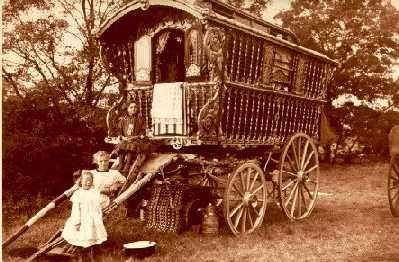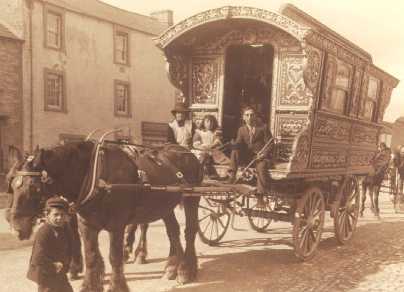Gypsy WagonsWelcome to my online photo album.
|
 Gypsy Reading Wagon
Gypsy Reading Wagon
|
 Traveller's Wagon
Traveller's Wagon
Irish Travellers (sometimes known as "itinerants" or "Tinkers") are a very small minority group in Ireland. They make up less than 1% of the population with approximately 23,000 people in the Republic and another 1,500 in the North. It is also estimated that there are about 15,000 Irish travellers in Britain and another 7,000 in the USA. Irish Travellers belong to a distinct ethnic group within Ireland. They have their own language, beliefs and social customs which have been made stronger over time due to their exclusion and marginalisation from mainstream "settled" society. Occasionally Irish Travellers have been confused with the Roma or Gypsies in England, who despite centuries of coexistence, cultural interchange and limited intermarriage, remain a distinct people. Until not so long ago Irish Travellers were referred to as "Tinkers". This word referred to their occupation as tinsmiths and metalworkers and was derived from the Irish word "ceard" (smith) or "tinceard" (tinsmith). This word is now generally used in a derogatory sense. Most of the Travellers' traditional crafts such as spoon-mending, tinsmithing and flower-making have gone by the way now as a result of urbanisation and the introduction of plastic and industrial technology. Traveller musicians have included the great uilleann piper Felix Doran and the world-renowned folk musicians The Furey Brothers. The music and singing of the Irish Travellers have been in decline since urbanisation and the arrival of television. Fewer Travellers now rely on singing and making music for their livelihood as in times gone by. There are a number of theories as to the origin of the Irish Travellers. Their secret language, Shelta, and the evidence of various historical references to them would seem to indicate that they are the remnants of an ancient class of wandering poets, joined by those who were pushed off the land during different times of social and economic upheaval such as Cromwell's campaign of slaughter, the Battle of the Boyne (1690) and the Battle of Aughrim (1691). Many of the Travellers may also be the descendants of people who were left homeless as a result of the Irish potato famines of the nineteenth century. External links: Irish Travellers
Shelta: the language of the Irish Travellers The Travelling people form a distinct group within Irish society, and have their own secret language Shelta, also known as Gammon or Cant. Shelta had distinctive forms in the past, relating to occupation, although the differences in dialect are much less clearly defined today between the various strata of Traveller society . Both the Celtic scholar Kuno Meyer (1858-1919) and the Romani scholar John Sampson (1862-1931) believed Shelta to be a language that was centuries old, perhaps from as far back as before the thirteenth century. Meyer believed that Shelta was "once possessed by Irish poets and scholars, who, probably were its original framers". He maintained that there were elements in the language which only scholars could have introduced: these included the names of characters from the ancient Ogham alphabet, and borrowings from Greek and Hebrew. Structurally Shelta is more similar to English than it is to Irish Gaelic, although the core of its vocabulary has Gaelic origins. Shelta also includes elements from several varieties of British cant as well as from English and from Anglo-Romani. |
 Traveller's Wagon
Traveller's Wagon
The Romany Gypsies seem to have taken to the wagon or vardo about the middle of the nineteenth century. George Borrow writing in his Romano Lavo-Lil, which he finished in 1873, says that the caravans were not very numerous on the roads at this stage and it is true that many Gypsies continued to live in bender tents right up to the end of the century. The Gypsy style of wagon was certainly in vogue however, even as early as 1840 when Charles Dickens described Mrs. Jarley's van with its bed, stove, closet or larder and several chests (Old Curiousity Shop, ch. xxvii):
One half of it... was carpeted, and so partitioned off at the further end as to accomadate a sleeping-place, constructed after the fashion of a berth on board ship, which was shaded, like the windows, with fair white curtains... The other half served for a kitchen, and was fitted up with a stove whose small chimney passed through the roof. It also held a closet or larder, several chests, a great pitcher of water, and a few cooking-utensils and articles of crockery. These latter necessaries hung upon the walls, which in that portion of the establishment devoted to the lady of the caravan, were ornamented with such gayer and lighter decorations as a triangle and a couple of well-thumbed tambourines
There are five main types of Gypsy and hawkers' living-wagons. These include the Bow-topped Wagon, two versions of which were the Spindle-sided Potter's Four-wheeled Cart and the Two-wheeled Sleeping Cart which was used by the Staffordshire salt-hawkers. Other types included the the Cottage-shaped or Ledge Wagon, the Brush Wagon and the Straight-sided Wagon which was also known as the Showman's Wagon. It was probably in the Reading Wagon or the old type of Gypsy vardo, however, that the Gypsy wagon reached its highest and most characteristic form. This was a wagon with large wheels running outside the body of the van, which slopes outwards considerably towards the eaves. During the heyday of the vardo the family most widely reputed as builders were the Duntons of Reading. The vardo became the Gypsy woman's most coveted possession, the paramount domestic status symbol. As Rodney Smith, better known as 'Gipsy' Smith, the evangelist, says in his autobiography describing Gypsy life in the late 1800's:
The young gipsy couple started their married life by purchasing a waggon. This costs anywhere from £40 to £150 ans is obtained from a gorgio waggon-builder. Oddly enough, the gipsies never learn the trade of making their own waggons. The waggons are very warm and very strong, and last a great many years. The young husband is, of course, the manufacturer of the goods, and his wife the seller. When she leaves the waggon in the morning to go her rounds she arranges with her husband where the waggon shall be placed at night, and thither she betakes herself when her day's toil is over. In the course of the day she may have walked from fifteen to twenty miles. If the husband has been refused permission to stand his waggon on the arranged spot and has had to move on, he lets his wife know where he is going by leaving behind him a track of grass.
After 1920 the travelling showmen who had toured the country in their Burton wagons turned over their pulling power from horse and steam to petrol and oil and by the 1930's very few of them travelled in the old way. The Romanies still clung to their vardoes, although the economics of their way of life was in upheaval due to the contraction in the horse-trading industry and the changes from their traditional crafts to scrap-dealing and tarmacing. While most Gypsies have gone over to trucks and trailers and despite the fact that only about one per cent of the traveller population still live in horse-drawn waggons, the tradition of the vardo is still very much alive as can be witnessed on an annual basis at the large Gypsy fair in the town of Appleby, Cumbria, every summer. |